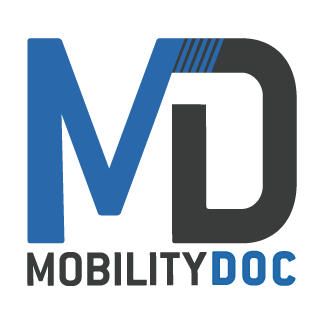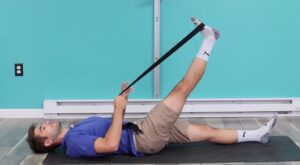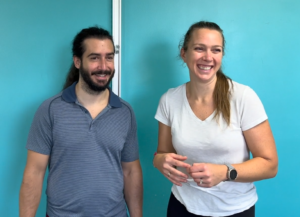AI is everywhere right now—and if you’re dealing with pain or an injury, there’s a good chance you’ve typed something like “PT program for shoulder pain” into ChatGPT. But how good is it… really?
Of course we decided to find out. We asked ChatGPT to create a home physical therapy program for our shoulder, and then we took it a step further—refining the prompts, reviewing the output, and exploring how you can actually use AI to create smarter, more functional PT workouts at home.
The Basic Prompt
We began with a super basic prompt:
“Make me a home PT program for my shoulder.”
Right away, ChatGPT followed up with some solid clarifying questions:
- What’s the issue or diagnosis?
- Which side is affected?
- How long has it been bothering you?
- What movements aggravate it?
- What equipment do you have access to?
- Current pain level and range of motion?
Any movement restrictions from a doctor?
Honestly… that’s a strong start. These are the exact kinds of questions a good clinician would ask to get some direction. So we gave ChatGPT our answers:
- Biceps tendinitis
- Right side
- It’s been bothering us for 1 month
- Pull-ups aggravate it
- We have access to free weights, bands, a barbell, and a cable machine
- Pain ranges between 0–5, with full ROM
- I didn’t go to a doctor

From there, ChatGPT built a structured 3x/week program, each session around 25–30 minutes. Here’s what it gave us:
ChatGPT’s Program
- Band-resisted rows
- Arm circles
- Scap pushups
- Cable rope face pulls (light)
- Sleeper stretch
- Wall slides with band
- Pec minor foam rolling
- Doorway stretch
- Isometric biceps curls at 90° elbow bend
- Eccentric dumbbell curls
- Band shoulder ER at sides
- Wall slides with light dumbbells
- Prone YTWs
- Cable or band reverse flys
- Single-arm DB rows with scap squeeze
- Serratus wall slides
- Cross-body adduction stretch
- Forearm flexor/extensor rolling
- Biceps stretch against the wall
Our Review: Solid Concepts, But Some Misses
There’s definitely good structure here. ChatGPT included a warm-up, tendon safe mobility, controlled loading, scapular strengthening, and optional recovery. What really impressed us was including eccentrics and isometrics. These types of exercises are clinically proven to be great for tendon recovery. But… not everything hit the mark.
Some of the exercises are not useful or are just too much. Arm circles are not great, wall slides with dumbbells are too much, and foam rolling your forearm? Basically impossible and not very effective.
The biggest issue? Volume. Way too many exercises crammed into one session—supposedly in under 30 minutes, and repeated three times a week. That’s a lot, and it misses the opportunity for a more well-rounded, progressive plan.

Better Prompts = Better Programs
We decided to refine the prompt and ask:
“This is too many exercises and I don’t want to do the same workout 3 days a week.
Give me a workout that covers one exercise for each of the following: flexibility, stability, strength. Do this like a circuit for 3 rounds. And then finish with an additional exercise for focusing on strength at my bicep or shoulder. This should still only take me 30 minutes roughly.”
And now? The response was so much better. ChatGPT gave us a 3-day program with a fresh circuit each day with exercises that focus on flexibility, stability, and strength:
ChatGPT's New Program
- Sleeper stretch
- Wall slides with foam roller
- Single-arm DB row (eccentric)
- Isometric biceps curl
- Pec minor wall stretch
- Serratus wall slides
- Cable or band reverse flys
- Eccentric biceps curl
- Cross-body shoulder stretch
- Band ER at 90° abduction
- Prone T raises
- Incline DB curl
Why This Works
Each day has a clear theme and a manageable workload. You’re hitting the key areas—flexibility, stability, and strength. It’s also realistic. Nobody wants to repeat the same 40-minute grind three times a week. You’re getting structure, progression, and variability—all with the flexibility to swap in equipment or modify intensity.
Our Final Thoughts on Using ChatGPT for PT
Can ChatGPT replace a physical therapist? No.
But can it help you build a smarter, more organized home program if you know how to prompt it right.
Here’s the key:
Be specific. The more detail you give, the better the output.
Think like a clinician. Structure your ask like a movement professional would.
Watch your time. Too many exercises? Refine the prompt.
Still in pain after 2–3 weeks? See a specialist. Don’t DIY forever.
Want Help Creating a Real Program?
We’re big fans of using smart tools. But nothing beats working with professionals who know your body, your goals, and your movement story.
Reach out to us at Mobility-Doc to build a custom recovery or performance program to fit your specific needs. Never stop doing what you love.
Already Made Programs
Stop letting those little tweaks turn into big problems! MDRx programs are designed to keep your joints strong and your body moving well—so you can train, compete, and recover without those nagging aches getting in the way.
Built from years of working with real athletes and active patients in our clinic, these 4-week programs target the most common pain points by body region or sport. No more guessing. Just clear, effective plans that actually make a difference.
Ready to take care of it before it puts you on the sidelines?
Find your MDRx program





